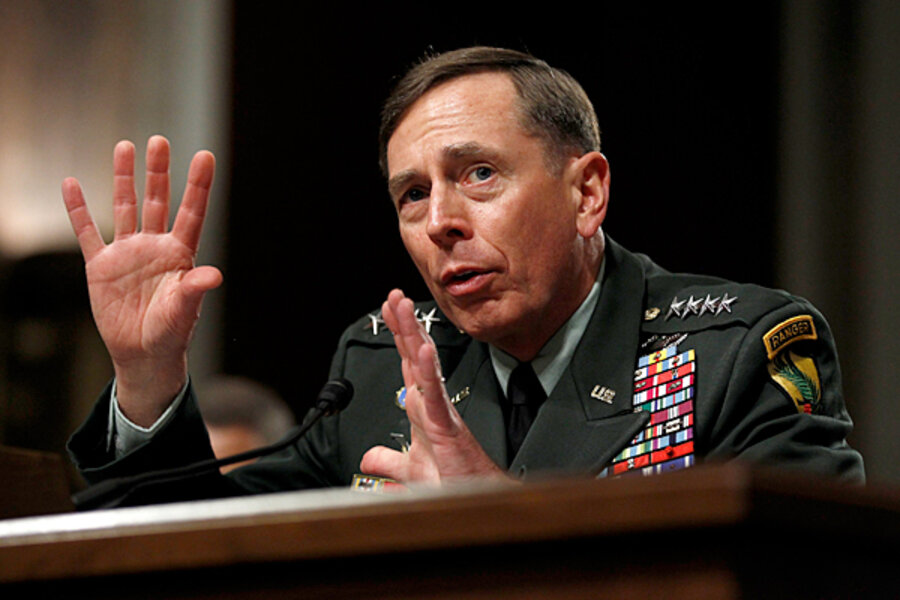Afghanistan war: General Petraeus rethinking rules of engagement
Loading...
| Kabul, Afghanistan
This month has been the deadliest of the Afghanistan war for foreign troops, and General David Petraeus said at his confirmation hearing today that he’s considering relaxing tough rules of engagement put in place by his predecessor because he says he fears they’re putting US forces in greater danger than they need to be.
“I am keenly aware of concerns by some of our troopers,” Petraeus said in prepared remarks to the House Armed Services Committee. “Those on the ground must have all the support they need when they are in a tough situation.”
The rules of engagement, which require stricter reviews of requests for the use of air power in the field than in the past and set strict protocols on when and how soldiers can use deadly force, were drawn up by Gen. Stanley McChrystal to limit the civilian casualties that infuriate Afghans and have been one of the Taliban’s best recruiting tools.
But average soldiers say they feel like their hands are tied by the rules, both putting themselves at greater risk and giving insurgents time to escape after taking potshots at NATO forces.
130 Taliban leaders killed
June has been the deadliest month of the war for foreign soldiers, with 101 killed. The previous deadliest month was August of 2009, with 77 foreign casualties.
That increase was to a certain extent expected, given the current surge of troops into the Afghan countryside, the first step in a plan that the US and its NATO allies hope will turn around the war. The current strategy is to dislodge the Taliban from ground they’ve held for years, and then bring construction projects and better government that NATO hopes will convince Afghan citizens to withhold support from the Islamist movement.
“From our perspective, while certainly these added casualties and the increased violence are unfortunate, it’s expected,” says Air Force Lt. Col. John Dorrian, an spokesman for the International Security Assistance Force (ISAF) in Kabul. “ISAF forces with their Afghan partners are challenging Taliban insurgents in territory that was in many cases completely controlled by them for years.”
Dorrian says growing casualties don’t mean that the Taliban are growing stronger or more capable. “We expect that there is going to be more violence throughout the summer, and then it’s going to improve. What you see is a manifestation of Taliban and the insurgency in general being attacked and slowly but surely dismantled. If anybody thinks the insurgents are gaining strength I would challenge that completely, because nothing could be further from the truth.”
He says that about 130 “Taliban commanders and subcommanders” have been captured or killed in the past four months throughout the country, mostly in the south, the heartland of the Taliban.
Since the war began, the strategic advantage of having killed Taliban leaders has been undermined by incidents of large numbers of civilian casualties in the airstrikes that targeted them, which prompted McChrystal’s tougher rules.
McChrystal's rules at work: women and children emerge unharmed
An incident this week outside Afghanistan’s second-largest city of Kandahar, illustrated both local sensitivities to US casualties and, according to an ISAF officer, how the rules are working.
On Monday, NATO troops killed an alleged local Taliban commander named Shyster Uhstad Khan. He was suspected of financing roadside bombs targeting NATO troops near the city. The raid on his compound left seven other fighters dead, though a relative of Mr. Khan told the Associated Press that all eight were innocent civilians.
The US officer said that after receiving intelligence on Khan’s location, NATO and Afghan forces surrounded his compound. From a distance, they gave instructions over a megaphone in both Pashto and Dari, Afghanistan’s most common languages, to two guards at the gate to lay down their weapons.
When they didn’t comply, the two men were shot. Then a second “callout” was delivered into the compound, warning everyone to come out unarmed. Shortly thereafter, about seven women and children emerged and were taken into custody. Then an assault team moved in. The men inside resisted and were killed.
“The way these night raids are done is under a strict protocol that General McChrystal imposed,” says the officer. “In every single one of them, Afghan officials are in the lead, they’re consulted before the raid and 80 percent of the time they’re able to capture the objective without firing a shot. When someone is killed it’s because of a conscious decision from the insurgent to fight.”
What precise changes Petraeus is considering in the rules of engagement here are not yet clear, thought he helped write the US counterinsurgency manual that stresses the importance of civilian casualties that deeply informed McChrystal’s approach while running the war.


